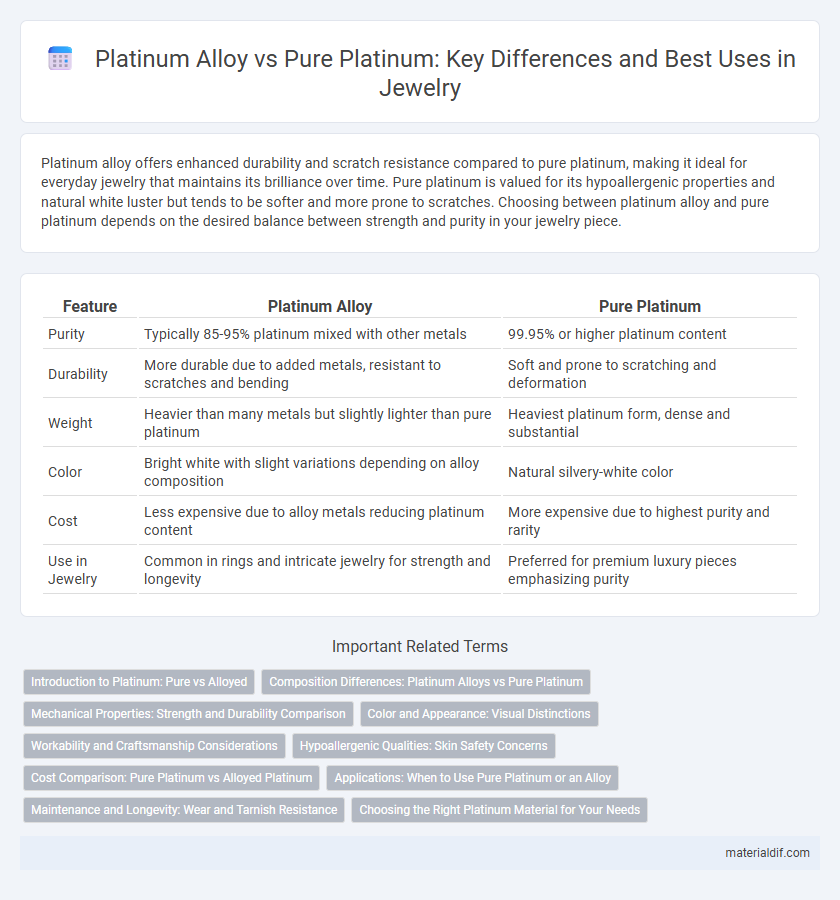Platinum alloy offers enhanced durability and scratch resistance compared to pure platinum, making it ideal for everyday jewelry that maintains its brilliance over time. Pure platinum is valued for its hypoallergenic properties and natural white luster but tends to be softer and more prone to scratches. Choosing between platinum alloy and pure platinum depends on the desired balance between strength and purity in your jewelry piece.
Table of Comparison
| Feature | Platinum Alloy | Pure Platinum |
|---|---|---|
| Purity | Typically 85-95% platinum mixed with other metals | 99.95% or higher platinum content |
| Durability | More durable due to added metals, resistant to scratches and bending | Soft and prone to scratching and deformation |
| Weight | Heavier than many metals but slightly lighter than pure platinum | Heaviest platinum form, dense and substantial |
| Color | Bright white with slight variations depending on alloy composition | Natural silvery-white color |
| Cost | Less expensive due to alloy metals reducing platinum content | More expensive due to highest purity and rarity |
| Use in Jewelry | Common in rings and intricate jewelry for strength and longevity | Preferred for premium luxury pieces emphasizing purity |
Introduction to Platinum: Pure vs Alloyed
Pure platinum is highly valued for its exceptional purity, corrosion resistance, and natural white luster, making it a premium choice for fine jewelry and industrial applications. Platinum alloys combine pure platinum with metals such as copper, iridium, or palladium to enhance durability, hardness, and color variation without compromising the metal's intrinsic qualities. The choice between pure platinum and platinum alloy depends on the intended use, balancing purity with mechanical strength and wear resistance.
Composition Differences: Platinum Alloys vs Pure Platinum
Platinum alloys combine pure platinum with other metals such as palladium, iridium, or cobalt to enhance hardness and durability, whereas pure platinum consists of 95-99.9% platinum with minimal impurities. The addition of alloying metals modifies the melting point, color, and workability, making alloys more suitable for practical applications like jewelry and industrial uses. Pure platinum is prized for its natural whiteness and hypoallergenic properties but is softer and more prone to scratches compared to alloyed variants.
Mechanical Properties: Strength and Durability Comparison
Platinum alloys exhibit superior strength and durability compared to pure platinum, making them more resistant to scratches and deformation under stress. The addition of metals such as ruthenium or cobalt enhances hardness, improving wear resistance while maintaining the metal's inherent corrosion resistance. Pure platinum's softness allows for excellent malleability but limits its mechanical performance in high-stress applications.
Color and Appearance: Visual Distinctions
Platinum alloy exhibits a slightly different color tone compared to pure platinum, often appearing whiter and sometimes showing subtle grayish hues due to the mixing of metals like palladium or iridium. Pure platinum possesses a naturally bright, silvery-white luster that remains consistent without tarnishing over time. These visual distinctions impact jewelry design choices, as alloys can enhance durability while slightly altering the metal's iconic appearance.
Workability and Craftsmanship Considerations
Platinum alloy offers enhanced workability compared to pure platinum due to the inclusion of metals such as palladium or cobalt, which increase hardness and reduce melting point, facilitating easier shaping and soldering during craftsmanship. Pure platinum, while valued for its purity and hypoallergenic properties, is softer and more prone to scratching, requiring skilled artisans to handle it with precision and care. The choice between platinum alloy and pure platinum depends on the balance between desired durability and the intricacy of the design in fine jewelry making.
Hypoallergenic Qualities: Skin Safety Concerns
Platinum alloys are often mixed with metals like copper or nickel, which can cause skin irritation or allergic reactions in sensitive individuals, whereas pure platinum is hypoallergenic and less likely to trigger skin allergies. The high purity of platinum (95% or higher in fine platinum) ensures excellent biocompatibility, making it ideal for people with sensitive skin or metal allergies. Jewelry made from pure platinum significantly reduces the risk of dermatitis and other skin safety concerns related to metal allergens.
Cost Comparison: Pure Platinum vs Alloyed Platinum
Pure platinum typically commands a higher price due to its 99.95% purity, making it more valuable than platinum alloys, which combine platinum with other metals to reduce cost. Alloyed platinum jewelry, often containing 85-95% platinum mixed with metals like iridium or palladium, offers greater durability at a lower price point while maintaining a similar aesthetic. The cost difference between pure platinum and alloyed platinum can range from 15% to 30%, depending on the alloy composition and current market prices for platinum and the added metals.
Applications: When to Use Pure Platinum or an Alloy
Pure platinum offers exceptional corrosion resistance and biocompatibility, making it ideal for medical devices, laboratory equipment, and high-precision jewelry. Platinum alloys, combined with metals such as ruthenium or cobalt, provide enhanced hardness and durability, suitable for industrial applications, automotive catalytic converters, and more robust jewelry pieces. Choosing between pure platinum and an alloy depends on the required balance of strength, wear resistance, and corrosion protection for specific applications.
Maintenance and Longevity: Wear and Tarnish Resistance
Platinum alloy offers enhanced durability and improved resistance to wear compared to pure platinum, making it ideal for daily use and high-stress applications. Pure platinum, while naturally resistant to tarnish, is softer and more prone to scratches and deformation, requiring more careful maintenance to preserve its finish. Both materials maintain excellent longevity, but alloys benefit from added strength that reduces the frequency of polishing and repairs.
Choosing the Right Platinum Material for Your Needs
Platinum alloy offers enhanced durability and scratch resistance compared to pure platinum, making it ideal for jewelry that withstands daily wear. Pure platinum, consisting of 95-99% platinum, provides exceptional purity and hypoallergenic properties preferred in sensitive skin applications. Selecting the right platinum material depends on balancing purity with practicality, where alloys deliver strength and longevity, while pure platinum emphasizes luxury and purity.
Platinum Alloy vs Pure Platinum Infographic

 materialdif.com
materialdif.com